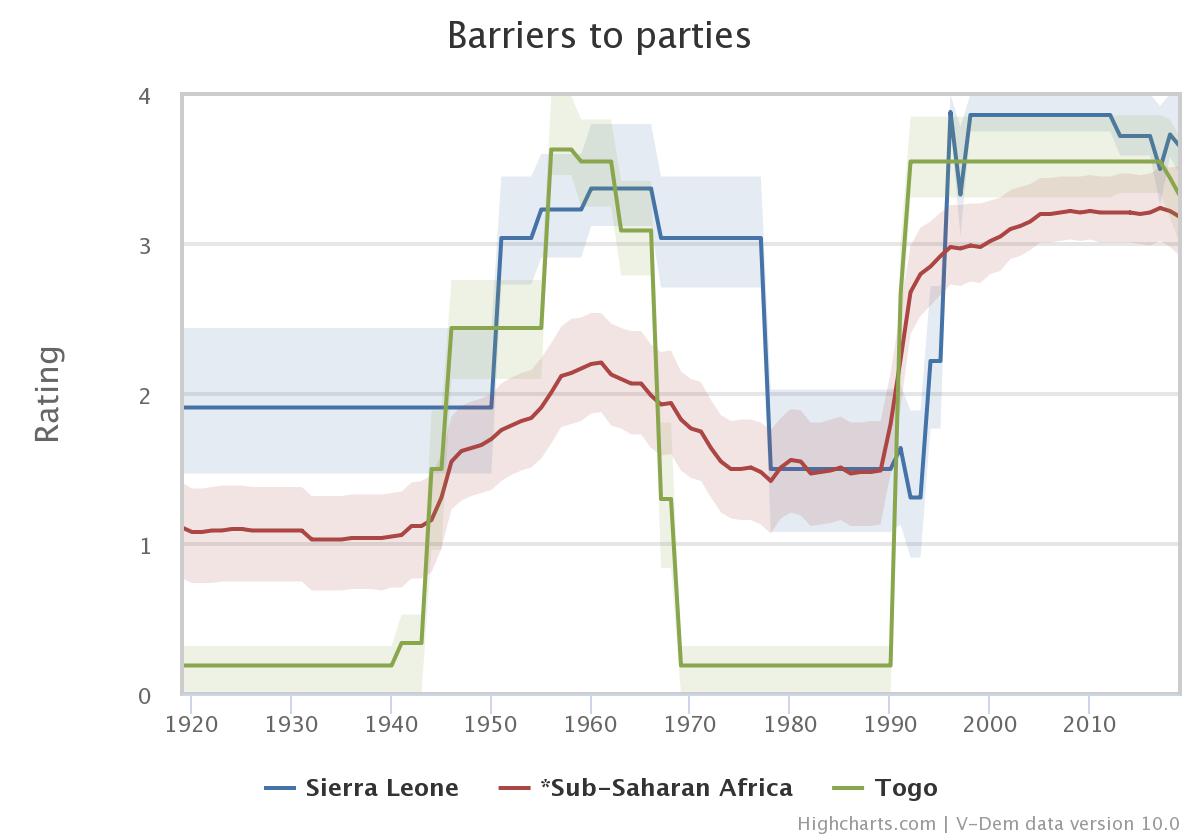Independence Day in Togo and Sierra Leone: The Role of Parties
By: Amanda B. Edgell
Apr 27, 2020
On 27 April, Togo and Sierra Leone celebrate their independence from France in 1960 and the United Kingdom in 1961, respectively. For these two West African countries, the formation of anti-colonial political parties played a key role in the struggle for independence. This graph of the week uses V-Dem data on barriers to political parties to illustrate how party politics have changed in Togo and Sierra Leone over the last century.
Using the Variable Graph online tool, we plot trends in Togo and Sierra Leone compared to the average for sub-Saharan Africa using the barriers to parties indicator. This variable captures the extent to which restrictions prevent individuals from forming political parties. As with most V-Dem indicators, the scale ranges from least to most democratic. Values of zero signify that no parties are allowed to exist whereas values of four indicate that there are no substantial barriers to party formation.
The graph illustrates some early differences between these two cases. During much of the colonial period, political parties were not allowed to form in French Togoland. As a result, ratings for Togo on the barriers to parties indicator are much lower than the average for the region until the early 1940s. By contrast, while those seeking to form parties in the British protectorate of Sierra Leone faced substantial obstacles until the 1950s, several early parties existed, including a branch of the National Congress of British West Africa (NCBWA) in 1919 and the West African Youth League (WAYL) in 1935, both of which pressed for decolonization. This is reflected in the higher scores for Sierra Leone on barriers to parties through the early 1940s, when compared to Togo and the regional average.
Things changed for both colonies in the 1940s and 1950s, with the lifting of some restrictions. The end of World War II saw French Togoland re-assigned as a UN trusteeship, prompting the first legislative elections in the territory in December 1946. This led to the formation of the anti-colonialist Party of Togolese Unity (Parti de l'unité togolaise, PUT) led by Sylvanus Olympio and French-backed Togolese Party of Progress (Parti togolais du progrès, PTP). In the lead-up to independence, the French gradually reduced barriers to parties, such that by the 1958 legislative elections in Togo, party formation was virtually unencumbered. As the graph shows, the British protectorate of Sierra Leone saw similar developments as it marched toward independence in 1961, although barriers to parties remained slightly more restrictive in that case.
Like much of the region, the Cold War brought periods of instability and single-party rule to Togo and Sierra Leone. As a result, despite the relatively low restrictions on party formation at independence, both countries saw these restrictions increase and associated declines on their barriers to parties scores in the 1970s and 1980s. The 1990s ushered in a period of democratization for both countries. Today, Togo and Sierra Leone again show higher scores on barriers to parties when compared to the regional average, reflecting the overall acceptance of multiparty politics in both countries.
To learn more about V-Dem data and make similar graphs for yourself, visit www.v-dem.net.


